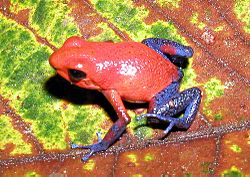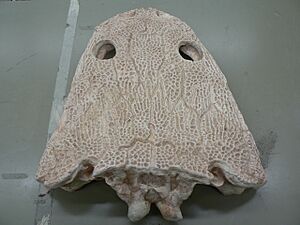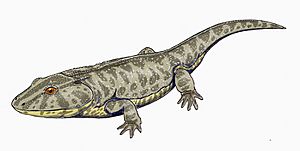Tetrapod facts for kids
Quick facts for kids TetrapodsTemporal range: Middle Devonian to Recent
|
|
|---|---|
 |
|
| Scientific classification | |
| Kingdom: | |
| Phylum: | |
| Subphylum: | |
| (unranked): | |
| Superclass: |
Tetrapoda
Broili, 1913
|
| Subgroups | |
|
|
Tetrapods are a group of vertebrate animals. The word "tetrapod" comes from Greek and means "four feet." This group includes all animals that have four limbs, or that evolved from ancestors with four limbs.
This means amphibians, reptiles, dinosaurs, birds, and mammals are all tetrapods. Even snakes, which don't have legs, are tetrapods. This is because their ancestors had four limbs.
The first tetrapods appeared a long time ago. They evolved from lobe-finned fish that could breathe air. This change likely happened during the Upper Devonian period. This means the first steps towards living on land happened while these animals were still mostly in the water.
Contents
How Tetrapods Evolved
Fishapods: The First Steps on Land
Scientists have found very old tracks of tetrapods. These tracks are from the mid-Devonian period in Poland. They are almost 400 million years old. This is 18 million years older than other tetrapod fossils found before.
These footprints were made in the mud of a warm, tropical lagoon. No other animal at that time could have made these tracks except a tetrapod. This discovery suggests that the animals making these tracks were still fish. They were not yet true amphibians living on land.
Scientists now use the term fishapod for these creatures. They came from lobe-finned fish. However, the exact type of fish they evolved from has not yet been found as a fossil. The Polish team thinks the change from fish to tetrapod might have happened even earlier, in the Lower Devonian.
Life in Water: Early Tetrapods
The earliest tetrapods lived completely in water. They could not live on land. Before these discoveries, many thought fish moved onto land to find food or water. Then, they were thought to have grown legs and lungs.
But new evidence shows the first tetrapods lived in watery places. These included shallow wetlands, coastal lagoons, and even shallow marine areas. This suggests that tetrapods evolved in these types of environments.
Fossils of early tetrapods are found across the Old Red Sandstone continent. This means they spread along coastlines. This shows they didn't just live in freshwater.
They might have spent short times out of the water. They could have used their legs to move through mud. The first tetrapods that truly lived on land appeared about 20 million years later. These were found in early Carboniferous rocks.
Over time, tetrapods adapted to land. They spent longer periods away from water. Young tetrapods might have spent more time on land before returning to water as adults. Adults might have also come out to warm up in the sun near the water's edge. The first true land tetrapods were small. They grew larger later on.
Romer's Gap: A Missing Puzzle Piece
Between the early fishapods and the first true amphibians and amniotes, there's a gap in the fossil record. This gap is about 30 million years long. It was first noticed by Alfred Romer in the 1950s and is called Romer's Gap.
In the 1990s, new fossils like Pederpes were found. These helped to fill some of the missing details. But the gap still hides parts of the story of how fish became tetrapods.
Recently, more fossils have been found in Scotland. These new finds include five new Tournaisian tetrapods. They give us more information about where these animals lived.
Scientists say that the Tournaisian period had many different types of tetrapods. These included relatives of Devonian forms and early amphibians.
An extinction event at the end of the Devonian period caused many old fish groups to die out. But new studies show how the surviving groups recovered and became more diverse. This led to the many different vertebrates we see today.
The split between amphibians and amniotes happened soon after this extinction event. This fits with genetic studies that place the split around 355 million years ago. This was only 4 million years after the end of the Devonian period.
The Amazing Cleidoic Egg
Amphibians lay their eggs in water. But all other tetrapods, called amniotes, lay cleidoic eggs. These eggs are like tiny, private ponds. They protect and feed the baby animal inside until it hatches.
This was a very important step in evolution. It allowed amniotes to live completely on land. Once amniotes could live away from water, they spread out into many different environments. This was a huge step for vertebrate evolution.
Stem Tetrapods: Early Branches
Stem tetrapods are early tetrapods that are hard to classify. They don't have all the features of the main tetrapod groups.
- Land-dwelling stem tetrapods: These were descendants of fishapods. They first lived partly in water and partly on land. Later amniotes and amphibians came from them. They could support their bodies on land for long times. They also had five fingers and toes on each limb. This is different from their fishapod ancestors.
- Stem tetrapods evolved into:
- Amphibia (like modern frogs and salamanders)
- Amniota
- Sauropsida (like modern reptiles and birds)
- Synapsida (like modern mammals)
Early Stem Tetrapod Fossils
Here are some early stem tetrapod fossils:
- Pederpes: An early tetrapod from 359–345 million years ago.
- Westlothiana: From 350 million years ago. It might be an early amniote or a close relative.
- Casineria: From 340 million years ago. It is considered a very early amniote.
- Protoclepsydrops: From 314 million years ago. It is likely the earliest synapsid.
- Hylonomus: From 312 million years ago. An early reptile (anapsid sauropsid).
- Paleothyris: From 312–304 million years ago. Another early reptile.
- Archaeothyris: From 306 million years ago. An early synapsid.
- Petrolacosaurus: From 302 million years ago. The first diapsid reptile.
The Tetrapod Family Tree
The tetrapod group separated from fish during the Devonian period. The amniotes were the first to lay cleidoic eggs.
The Synapsids (which include mammals) and the Sauropsids (which include reptiles) are closely related groups. It's important to know that reptiles did not directly lead to mammals. They are like cousins on the family tree.
{{clade |label1=Tetrapods |1=
| Amniotes |
|
||||||||||||||||||||||||||||||||||||
Warm-bloodedness evolved somewhere in the
synapsid–mammal transition.
? Warm-bloodedness must also have evolved at one of
these points – an example of convergent evolution.
Living Tetrapod Groups
There are three main groups of tetrapods alive today. Each group also includes many extinct animals:
- Amphibia: This group includes frogs, toads, newts and salamanders, and caecilians.
- Sauropsida: This group includes birds and modern reptiles (like lizards, snakes, and crocodiles).
- Synapsida: This group includes all mammals.
Remember, animals like snakes and caecilians are tetrapods even without legs. This is because they evolved from ancestors that had four limbs. The same is true for aquatic mammals like whales, whose ancestors lived on land.
Tetrapod Classification
Here is a simplified way to classify tetrapods:
- Phylum Chordata (animals with a backbone)
- Class Sarcopterygii (lobe-finned fish)
- Subclass Tetrapodomorpha (fish that are close relatives to tetrapods)
- Eusthenopteron
- Panderichthys
- Tiktaalik
- Subclass Tetrapodomorpha (fish that are close relatives to tetrapods)
- Superclass Tetrapoda (animals with four limbs or their descendants)
- Pederpes
- Whatcheeria
- Class Amphibia (amphibians)
- (Subclass Labyrinthodontia)
- Subclass Lepospondyli
- Subclass Temnospondyli
- Subclass Lissamphibia (modern frogs, salamanders)
- Class Amniota (animals that lay cleidoic eggs)
- Class Sauropsida (reptiles)
- Class Sarcopterygii (lobe-finned fish)
* Class Aves (birds)
-
-
-
- Class Synapsida (mammal-like reptiles)
-
-
* Class Mammalia (mammals)
Images for kids
-
Devonian fishes, including an early shark Cladoselache, Eusthenopteron and other lobe-finned fishes, and the placoderm Bothriolepis (Joseph Smit, 1905).
-
Acanthostega, ≈365 Ma
See also
 In Spanish: Tetrapoda para niños
In Spanish: Tetrapoda para niños








